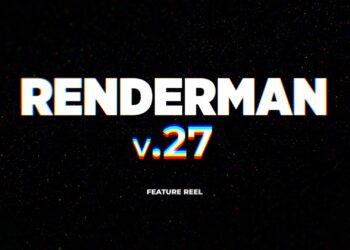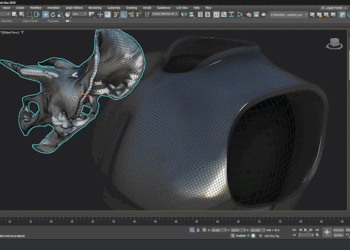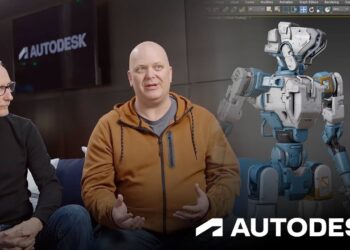Chaos has released the beta of V-Ray 7. One of the most interesting new features in this release a new plugin for rendering Gaussian splatting models. Also introduced is a new V-Ray Profiler for CPU rendering in 3ds Max, allowing users to assess rendering performance at a more granular level. Exporting to Chaos Scatter is now possible via GeomScatter, while users will find the redesigned Scene Converter and Bitmap Converter interfaces more intuitive. New lighting control options have been added with support for V-Ray Luminaires.
Chaos Scatter has seen several updates, including the introduction of an Instance Brush, which allows users to paint and modify scattered objects in a scene, and the addition of distribution maps. A new firefly removal algorithm has been added , improving the quality of final renders by eliminating bright, distracting artifacts.
For GPU rendering, V-Ray 7 introduces initial caustics support, a feature long requested by users, allowing for more accurate simulation of light as it refracts and reflects through transparent surfaces. V-Ray GPU now offers improved handling of bitmaps before they are transferred to the GPU, and introduces new options, such as a “separate folders” setting for render channels output and a more streamlined interface that hides unnecessary engine choices and removes outdated settings.
The V-Ray Frame Buffer has received several improvements, including freeform region rendering and a new Vignette Layer. Users can now drag and drop files directly into the VFB and have greater control over file format options when saving images from the standalone V-Ray renderer. Other improvements in the VFB include fine and step sliding controls for sliders, more precise control over chromatic aberration effects, and optimized performance for large images. The interface now supports improved color space handling in lookup layers and improvements to the Curves layer for more refined image adjustments.
In the V-Ray Lister, new features include the addition of a geometry tab and undo functionality, allowing users to more easily track and reverse changes. A new column for include/exclude options enhances scene management, while various refinements to scrolling, navigation, and usability have been made to streamline workflows.
Rendering start times have been optimized when using Chaos Scatter, and V-Ray Fur generation has been improved for faster hair rendering. Multi-threading has been applied to geometry compilation for the GeomInstancer, and there are now memory and performance enhancements when handling large bitmap files such as PNG, TIFF, and OpenEXR formats. HDR images also load more efficiently in this version.
V-Ray 7 includes several platform and architecture updates. The Windows builds now use vc143 by default, and the software can now be run in basic form without a GUI on Linux Arm64 systems. Support has been added for QT minimal and offscreen platforms, while the Optix 7.6 denoiser API has been integrated for improved denoising performance. USD support has also been updated to version 0.23.11, with installations moved to versioned folders.
Changes have been made to enhance proxy rendering and lighting systems as well. For instance, VRayProxy loading times have been improved through a preview override cache. V-Ray now supports large Gaussian splatting models, and intensity and color multipliers have been added for Gaussian splatting nodes. The software includes optimizations for rendering these splats more efficiently. Additionally, VRaySun and VRaySky now include an improved PRG sky model, and the default shadow bias for VRaySun has been adjusted to better match the behavior of other V-Ray lights.
V-Ray Lights has seen adjustments, such as listing VRayLuminaire in a separate category in the V-Ray Lister, adding missing parameters, and enabling animatable parameters for the Decay rollout in VRayLight. The software now also supports standalone volumetric instancing, allowing for better self-illumination and scene illumination with volumetric effects.
Other changes include redesigning V-Ray’s scene converter to allow preferences to be saved, and certain outdated features, such as the Bitmap to VRayBitmap converter, have been removed where no longer necessary.
In scripting, new MaxScript functions such as vrayTransferAutoExposure() allow users to transfer the last computed auto-exposure value to selected cameras, further enhancing control over scene lighting. Cryptomatte rendering has also been improved, with more precise naming conventions for saved files.
Much more is included, to see a full list, visit Chaos’ official changelog and visit the new V-Ray 7 Beta page.








Renderers has just been released with so few real new features that it feels like too far away from the days when I eagerly awaited each new version to see the latest advancements in optical physics. Nowadays, we don’t see those kinds of improvements anymore because the way images are generated has changed. AI can create images so quickly that traditional rendering is becoming a thing of the past. Saddly to a man that is addicted to create, shade, and light scenes.
Not even close. The V-Ray Suite of tools is amazing, and Vantage is a gamechanger. I can’t recall the last time I hit the render button. For the thematic work that I do for the attractions industry, AI is not something that will ever be usable. For the cookie cutter buildings that come out of Revit…maybe.
Don’t know if traditional renderers are a thing of the past , the downside to AI is it can’t do something like physically correct reflection . What most likely will happen is a combination of of 3D rendering an AI rendering to produce accurate artistic directed images .
Yes, you’re right. I was hasty in making such a statement. Sorry, everyone. It was a bad day.
This is such a rare thing to see nowdays (or ever) online, really mature and really refreshing kudos! this has really lifted my spirit today 🙂
is there really an AI render engine for 3d DCCs ?
i guess real time renderers are far better now
Been using vray for 10 years and been asking for a proper skin shader like the arnold sss shader that renders at least as fast for 10 years, i hope its there this time.
Another mediocre release following the trend since Vray Next.
All spotlights are on Vantage I guess, leaving VRay as an afterthought.
Long requested features from a decade ago, are still no where to be seen.
Vantage is very good for animation pre-vis, quick feedback on shading & lighting and then rendering the final sequence in Vray anyways for the highest quality.
But on its own? I wouldn’t render final animation sequences with it.. You can get better looking results from UE5 on average, tbh – and it’s expensive for small and mid-sized studios, which is a big downside.
Vray may lack some things but it’s still the best render engine for max, the most complete, versatile, and much faster in general. Comments here sounded like the decades old hate on 3ds max to me.
Well, to be perfectly honest… This is the kind of feature list I’d expect from Vray 6.3. Good to see optimizations and Vray GPU getting some attention, but is it enough in this day and age?
Considering the elephant in the room – Unreal Engine 5 getting ridiculously close in terms of quality to pure raytracers in many situations, or at least “good enough for the majority of client not to notice, and in real time to boot” – I would have expected something major as a selling point.
Agreed, not sure how they can compete with Unreal other than they have their existing customers. They’ve spread themselves too much and this no software progresses in leaps and bounds any more.
“good enough for the majority of client not to notice
This statement couldn’t be more true.
But as we are creatives, by nature we’re perfectionists. However, it’s only a matter of time until UE will be sufficient enough for our needs to satisfy the client.
V-Ray is great. I have not yet looked at V-Ray 7 but I do wish they would do more with the sun/sky/clouds feature in the renderer. They are limited to realism but I liked the options (and presets) in Vue’s Ozone. We’re artists. We’re not limited to what Mother Nature has already done. It’s a good start but our creativity is unlimited. V-Ray sky does not allow unlimited creativity.
Agreed, the sky althoug great needs some more love. Also, adding lo-res HDRI’s to flick through would be great.